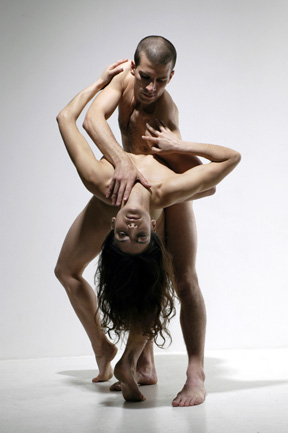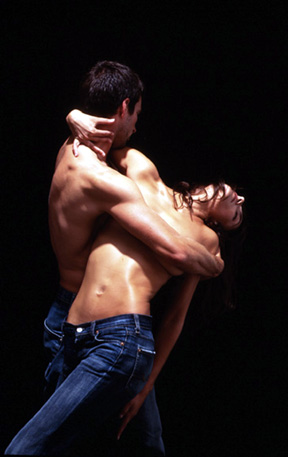“Naked"
George Piper Dancers
Sadler’s Wells Theatre
London
June 4-11, 2005
by
John Percival
copyright
©2005 by John Percival
 During
their twelve years as dancers with the Royal Ballet, Michael Nunn and
William Trevitt, besides rising to dance leading roles in the classics
and works by Ashton, MacMillan, Forsythe etc, began their joint private-enterprise
exercise of both still and video photography. That presumably helped give
them confidence, on deciding that Tetsuo Kumakova’s K Ballet in
Japan didn’t provide the opportunities they had hoped for when they
left the RB, to start their own group, George Piper Dances (taking the
title from their own middle names). Let me remind you that, calling on
Forsythe, Christopher Wheeldon, Russell Maliphant and others for new choreography,
they got five-star notices even before Sylvie Guillem joined them for
the recent “Broken Fall” programme about which I have already
reported enthusiastically. Now, strengthened by appointment as an associate
company of Sadler’s Wells, they have mounted their first two-act
dramatic ballet, “Naked”—and hardly anyone really likes
it.
During
their twelve years as dancers with the Royal Ballet, Michael Nunn and
William Trevitt, besides rising to dance leading roles in the classics
and works by Ashton, MacMillan, Forsythe etc, began their joint private-enterprise
exercise of both still and video photography. That presumably helped give
them confidence, on deciding that Tetsuo Kumakova’s K Ballet in
Japan didn’t provide the opportunities they had hoped for when they
left the RB, to start their own group, George Piper Dances (taking the
title from their own middle names). Let me remind you that, calling on
Forsythe, Christopher Wheeldon, Russell Maliphant and others for new choreography,
they got five-star notices even before Sylvie Guillem joined them for
the recent “Broken Fall” programme about which I have already
reported enthusiastically. Now, strengthened by appointment as an associate
company of Sadler’s Wells, they have mounted their first two-act
dramatic ballet, “Naked”—and hardly anyone really likes
it.
Don’t get me wrong: this isn’t a big 100% flop, there are flashes of theatrical tension and some good dancing, but they have made us expect better from them. Part of the problem is that, although they’ve done bits and pieces of choreography before, they are not really skilled dance-makers. Might they become so? I’m not sure. There are attractive dances in “Naked” but they are not very distinctive. Early announcements suggested that Maliphant would again do the choreography although to the specification of the two directors, but it has ended up with him listed only as “choreographic collaborator”, whatever that means. An official press release says that the show is directed and choreographed by Nunn and Trevitt, with “initial research for the choreography … undertaken in consultation with” Maliphant. And it looks like a copy or approximation rather than a true creation.
 The
dancers are fine. Nunn and Trevitt are joined by their highly gifted and
totally committed frequent partners Oxana Panchenko (from Kiev via English
National Ballet, Munich and other British ventures) and Monica Zamora
(from Bilbao via Birmingham Royal Ballet). They are both terrific, I’d
say actually outdancing the men until the latter get to their fine fierce
five-minute final duet. Two new recruits, Yvette Halfhide and Thomas Linecar,
fit in well enough.
The
dancers are fine. Nunn and Trevitt are joined by their highly gifted and
totally committed frequent partners Oxana Panchenko (from Kiev via English
National Ballet, Munich and other British ventures) and Monica Zamora
(from Bilbao via Birmingham Royal Ballet). They are both terrific, I’d
say actually outdancing the men until the latter get to their fine fierce
five-minute final duet. Two new recruits, Yvette Halfhide and Thomas Linecar,
fit in well enough.
But where the ballet falls down, besides the choreography, is in its structure. The creators write that an early seed was a duet requested by Lord Gavron, media baron and philanthropist, for his wife’s birthday. Key movements and the style from that are said to echo in the present work, but they also write of changing context, content, running order and music, as if they were jiggling about haphazardly. They told an interviewer during rehearsals that they were playing with the idea whether they were three couples or three versions of the same couple. Presumably they did eventually make up their minds, but what their decision was doesn’t become clear. We just get various duets, not always with the same partner, sometimes solos or a trio, often two or three couples on stage together. There’s a frequent licentious overtone; Trevitt gets his kit off (side and rear view) and Zamora flashes her breasts. Spiked heels and bare feet at various times affect the movement, which (we are told) the dancers had some freedom to invent for themselves.
Bob Crowley’s set shows two walls of a room, containing windows, a doorway (but no door) and, for the first half, a bed. Paule Constable lights it white in Act One, and Hugo Glendinning’s video projections show oversized dancers moving within or beyond it. In Act Two the set turns black and lighting by Michael Hulls picks out the dancers. This, Nunn has said, is because “something happens” to disrupt the white world. What that something is, I am still wondering. Using a décor is new for George Piper, and this one apparently brought memories of hotel or motel rooms which sparked thoughts of transient relationships. Using two lighting designers for one ballet is probably new to all of us. Multiple music sources are more familiar; “Naked” uses dreary selections from albums by Murcof, plus an unspecified contribution by Richard English, who often works with Maliphant, and a couple of songs by Doris Day (“Perhaps, perhaps, perhaps”) and Patsy Cline (“Three cigarettes in an ashtray”). That’s a lot of collaborators, so far to little effect. Well, it’s now going on tour. Let’s hope that Nunn is right in claiming that all their work tends to grow and develop with performance: there’s plenty of scope for that here.
Both photographs are by Hugo Glendinning. The dances are William Trevitt and Monica Zamora.
Volume 3,
No. 23
June 13, 2005
copyright
©2005
John Percival
www.danceviewtimes.com
|
|